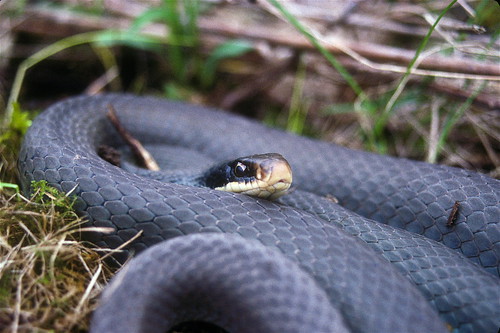
Coluber constrictor (blue racer) Ann Arbor, Washtenaw County Michigan, 1997
I love this shot; especially that the depth of field (DOF) is shallow and dead on with the eye. If you look at the large version on Flickr, you will see that the tip of the snout is just at the end of the area of focus and is a bit fuzzy. The out of focus parts of the snake exaggerate the length and draw your attention to the obvious glare of the subject. DOF is the phrase that describes the area in front and behind the focal point that are would be described as having acceptable sharpness.
I had everything going for me. It is a pre-digital taken with Minolta X370 and a Tamron 70-300SP on Ektachrome 200. I was about 5-6 feet back with the lens at 300mm, it's not recorded, but it was a cloudy day so I'm sure that I was shooting with the aperture pretty open. I was going to launch into a long discussion of factors controlling DOF, but there are others who have done a better job of explaining than I could. They involve issues of constant magnification, circles of confusion, and effective apertures.
Still for most, there are three classic factors to consider when controlling DOF, and the greatest impact is on those who use digital SLRs and SLRs. Point and shoot cameras are at a disadvantage for creating images with shallow DOF. These are the focal length of the lens, distance from the subject, and aperture (how much the iris is opened for the shot). To minimize depth of field, long focal length (telephotos), being closer to the subject, and large apertures (actually the smaller numbers f/1.8, f/2.8 rather than f/16) are better. Of course, the opposite is true when trying to broaden the DOF.
An important fourth factor that has more relevance with the advent of digital photography is the size of the sensor. If you have ever tried to get shallow depth of with a point and shoot digital, even if you can control the aperture, you have likely been left wanting. It hasn't been talked about much because a camera owner can do little about sensor size, whether that sensor is electronic or film, and on many less expensive cameras you have little control over the primary controlling factor, aperture. I shoot with cropped sensor cameras, that is cropped compared to 35mm film equivalent sensors like ones found in the Canon 5DmII or the 1DsmIV. This smaller sensor means with all other things being equal, the area of adequate sharpness is going to be about 1.6 times greater than "full-frame" cameras. So, if you want to take photos where you can easily control DOF, think bigger, and generally, more expensive. The larger the sensor, the easier it will be for you to control what is rendered as being in focus and what is not.

No comments:
Post a Comment